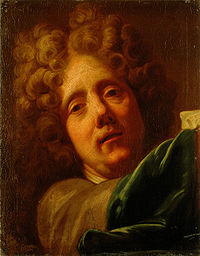
Jean Jouvenet
Encyclopedia

He was born into an artistic family in Rouen
Rouen
Rouen , in northern France on the River Seine, is the capital of the Haute-Normandie region and the historic capital city of Normandy. Once one of the largest and most prosperous cities of medieval Europe , it was the seat of the Exchequer of Normandy in the Middle Ages...
. His first training in art was from his father, Laurent Jouvenet; a generation earlier, his grandfather, Noel Jouvenet,
may have taught Nicolas Poussin
Nicolas Poussin
Nicolas Poussin was a French painter in the classical style. His work predominantly features clarity, logic, and order, and favors line over color. His work serves as an alternative to the dominant Baroque style of the 17th century...
.
Jouvenet early showed remarkable aptitude for his profession, and, on arriving in Paris, attracted the attention of Le Brun
Charles Le Brun
Charles Le Brun , a French painter and art theorist, became the all-powerful, peerless master of 17th-century French art.-Biography:-Early life and training:...
, by whom he was employed at Versailles
Versailles
Versailles , a city renowned for its château, the Palace of Versailles, was the de facto capital of the kingdom of France for over a century, from 1682 to 1789. It is now a wealthy suburb of Paris and remains an important administrative and judicial centre...
, and under whose auspices, in 1675, he became a member of the Académie royale, of which he was elected professor in 1681, and one of the four perpetual rectors in 1707. He also worked under Charles de La Fosse
Charles de La Fosse
Charles de La Fosse , French painter, was born in Paris.He was one of the most noted and least servile pupils of Le Brun, under whose direction he shared in the chief of the great decorative works undertaken in the reign of Louis XIV. Leaving France in 1662, he spent two years in Rome and three in...
in the Invalides
Les Invalides
Les Invalides , officially known as L'Hôtel national des Invalides , is a complex of buildings in the 7th arrondissement of Paris, France, containing museums and monuments, all relating to the military history of France, as well as a hospital and a retirement home for war veterans, the building's...
and Trianon
Grand Trianon
The Grand Trianon was built in the northwestern part of the Domain of Versailles at the request of Louis XIV, as a retreat for the King and his maîtresse en titre of the time, the marquise de Montespan, and as a place where the King and invited guests could take light meals away from the strict...
.
The great mass of works that he executed, chiefly in Paris, many of which, including his celebrated Miraculous Draught of Fishes (engraved by Audran; also Landon, Annales, i. 42), are now in the Louvre
Louvre
The Musée du Louvre – in English, the Louvre Museum or simply the Louvre – is one of the world's largest museums, the most visited art museum in the world and a historic monument. A central landmark of Paris, it is located on the Right Bank of the Seine in the 1st arrondissement...
, show his fertility in invention and execution, and also that he possessed in a high degree that general dignity of arrangement and style which distinguished the school of Le Brun. Anthony Blunt
Anthony Blunt
Anthony Frederick Blunt , was a British art historian who was exposed as a Soviet spy late in his life.Blunt was Professor of the History of Art at the University of London, director of the Courtauld Institute of Art, Surveyor of the King's Pictures and London...
found in Jouvenet's manner reminiscences of Poussin, Le Sueur
Eustache Le Sueur
Eustache Le Sueur or Lesueur , one of the founders of the French Academy of Painting, was born in Paris, where he passed his whole life....
, and the late work of Raphael
Raphael
Raffaello Sanzio da Urbino , better known simply as Raphael, was an Italian painter and architect of the High Renaissance. His work is admired for its clarity of form and ease of composition and for its visual achievement of the Neoplatonic ideal of human grandeur...
, but with a characteristic Baroque
Baroque
The Baroque is a period and the style that used exaggerated motion and clear, easily interpreted detail to produce drama, tension, exuberance, and grandeur in sculpture, painting, literature, dance, and music...
emotionalism that "is still far from the full Baroque ... His compositions are primarily planned as high reliefs, and the movements are in sharp diagonal straight lines rather than in curves." The naturalism of Jouvenet's style sets his work apart from most of the religious painting of his time.
Jouvenet died on 5 April 1717, having been forced by paralysis during the last four years of his life to work with his left hand.
Rediscoveries
- Darius and Alexandre, circa 1670, graphite on blue paper, study for the canvas offered to the Lycée Louis-le-Grand (Paris) by the King Louis XIV in 1674 (rediscovered in 2006 by Prof. Alain Béjard & Dimitri Joannidès, Alicem Institute, Luxemburg)

